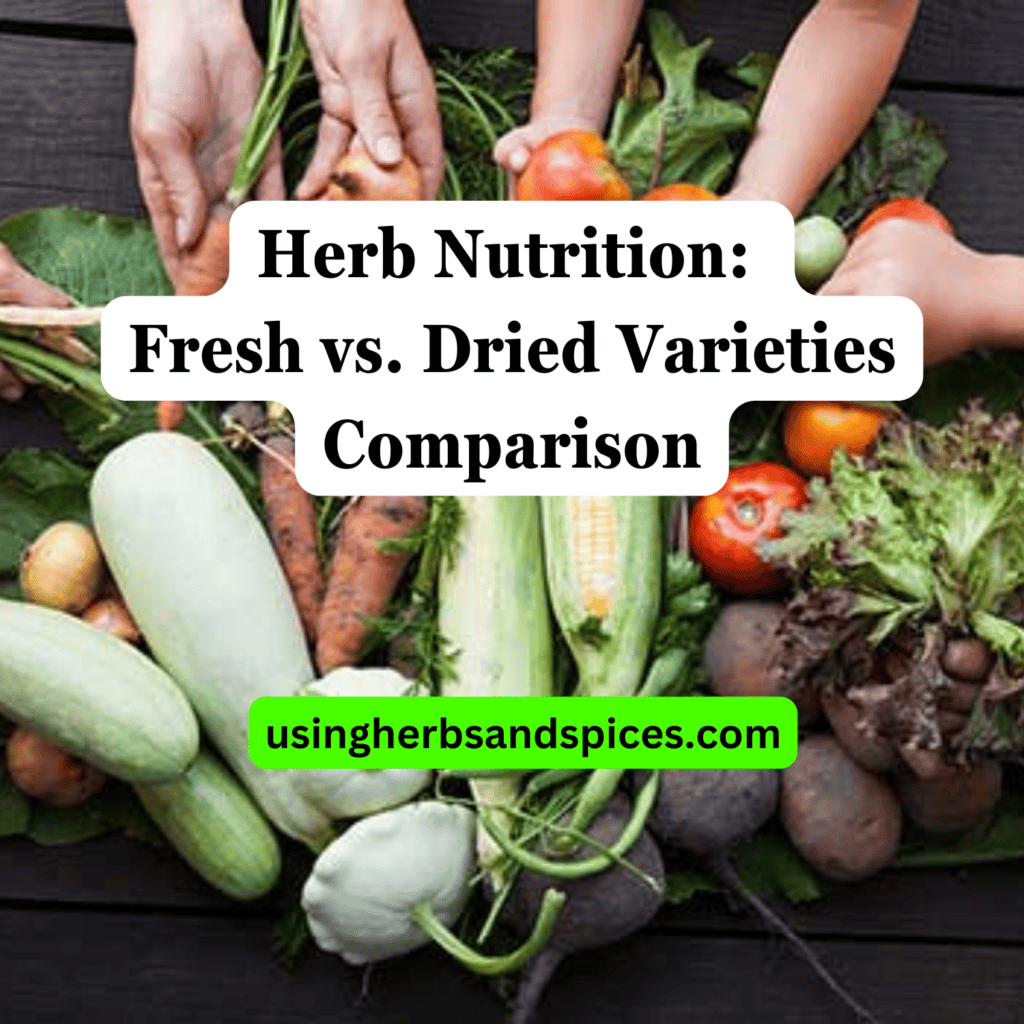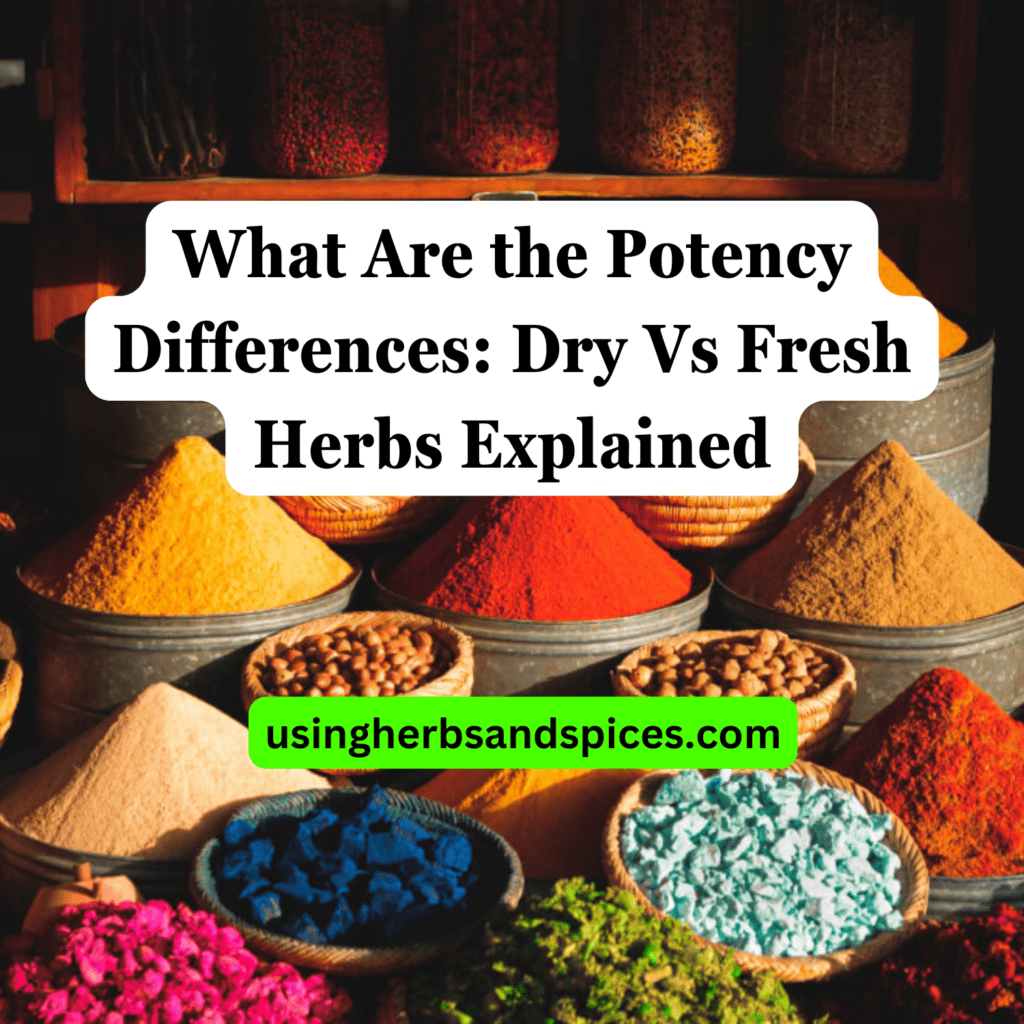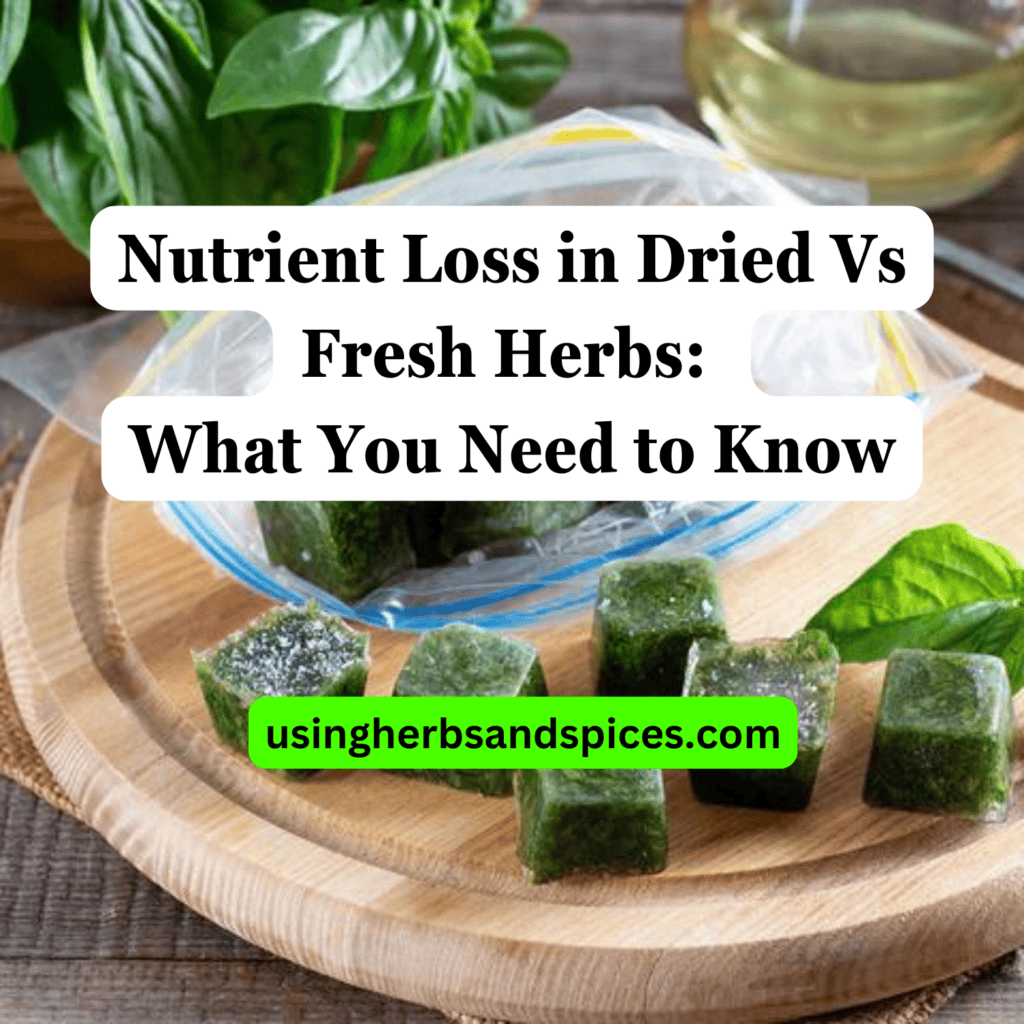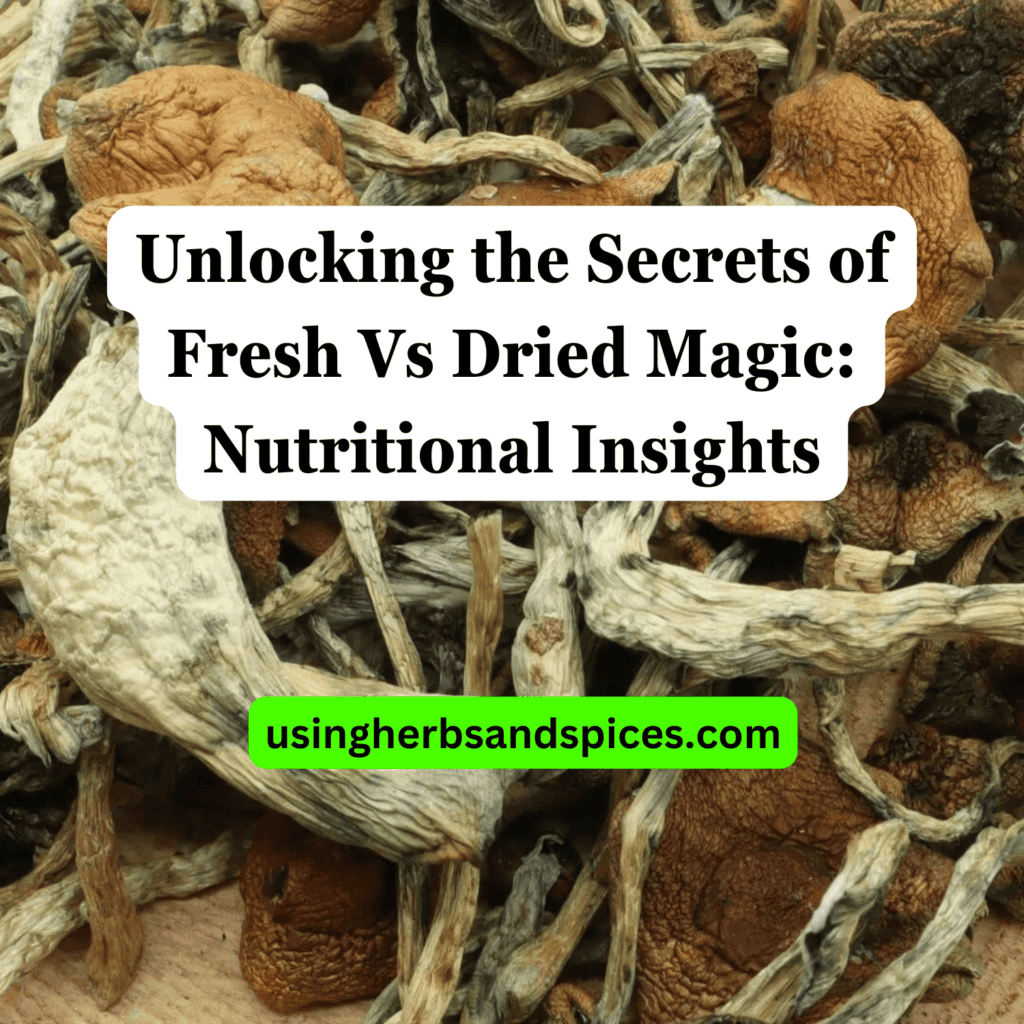SUMMARY: Fresh herbs bring brighter flavors and often more vitamins, while dried herbs offer a concentrated, longer-lasting option and can be better for cooked dishes. Knowing when and how to use each form maximizes the nutritional benefits they bring to your meals.
Ever wondered if there’s a real difference between using fresh and dried herbs in your cooking?

You’re not alone; it’s a common question among health-conscious cooks wanting to maximize the nutritional value of their meals.
- Understanding the basics: Fresh vs. Dried Herbs
- Nutritional Profile: A Comparative Look
- The Impact of Cooking on Herb Nutrition
- Practical Tips for Incorporating Herbs into Your Diet
Keep reading to better understand how your choice between fresh and dried herbs can influence the nutritional quality of your dishes, empowering you to make informed decisions.
Unveiling the Basics: Fresh vs. Dried Herbs
Embarking on a culinary adventure often involves a choice between fresh and dried herbs. Fresh herbs, celebrated for their vibrant color and potent aroma, are typically used to finish dishes, imparting a burst of fresh flavor. Dried herbs, on the other hand, are known for their concentrated taste and are usually added during the cooking process, allowing their flavors to meld with the other ingredients.
Understanding the distinction between fresh and dried herbs extends beyond just flavor and usage; it’s about appreciating how these forms affect the overall character of your cooking. Fresh herbs, with their delicate textures, are often best added towards the end of the cooking process or used raw to preserve their essence. Conversely, dried herbs, which undergo a process of dehydration, offer a more robust and earthy flavor profile, making them ideal for longer cooking times.
The choice between using fresh or dried herbs is not merely a matter of taste but also involves practical considerations such as shelf life and availability. Fresh herbs, although preferable for their flavor, have a relatively short shelf life and may not always be available depending on the season. Dried herbs, with their significantly longer shelf life, provide a convenient and versatile alternative, ensuring that your favorite flavors are always within reach.
In the end, whether you lean towards fresh or dried herbs depends on the specific demands of your dish and personal preference. Recognizing the unique contributions of each can elevate your cooking, marrying flavors in a harmony that delights the palate.
Nutritional Profile: A Comparative Look
When it comes to nutritional value, both fresh and dried herbs have their place in a balanced diet. However, their nutritional profiles change significantly through the drying process. Fresh herbs often boast higher water content, which makes them less concentrated than their dried counterparts. This means that, gram for gram, dried herbs can pack more nutrients – including vitamins and minerals – than fresh herbs.
For instance, dried herbs typically contain more antioxidants per gram compared to fresh herbs. Antioxidants are crucial for fighting free radicals, reducing oxidative stress, and potentially lowering the risk of chronic diseases. Additionally, drying herbs preserves certain vitamins, such as Vitamin K, which plays a vital role in blood clotting and bone health. However, it’s important to note that the drying process can reduce the levels of some vitamins, particularly Vitamin C, which is sensitive to heat and air.
While dried herbs offer the advantage of concentration, fresh herbs provide a vibrancy and a different spectrum of benefits. Fresh herbs can contain higher levels of certain water-soluble vitamins and volatile oils, responsible for their distinct aromas and flavors, which can have various health benefits, including anti-inflammatory and anti-bacterial properties.
Ultimately, the choice between fresh and dried herbs may come down to specific nutritional needs, personal taste preferences, and the intended use in cooking. Incorporating a mix of both fresh and dried herbs into your diet can be a great way to enjoy a wide range of flavors while benefiting from their varied nutritional profiles.
The Impact of Cooking on Herb Nutrition
When it comes to cooking with herbs, the manner in which they are used can significantly affect their nutritional output. Fresh herbs, often added towards the end of the cooking process, tend to retain more of their essential oils and aromatic properties. These oils are not only responsible for the herbs’ distinctive flavors but also for many of their health benefits, including anti-inflammatory and anti-bacterial effects.
Dried herbs, on the other hand, are more suited for dishes that require longer cooking times. Due to their concentrated nature, dried herbs can withstand extended periods of heat without losing as much of their flavor profile. However, it’s important to note that prolonged cooking can lead to a reduction in certain heat-sensitive nutrients, such as vitamin C and B vitamins, regardless of whether the herb is fresh or dried.
One key consideration is the “conversion” between fresh and dried herbs. Generally, because dried herbs are more concentrated in flavor, a smaller quantity is required to achieve the same taste profile as fresh herbs. A good rule of thumb is to use one-third the amount of dried herb when substituting for fresh. This adjustment not only ensures the intended flavor balance but also helps in managing the nutrient content delivered by the herbs.
To maximize the nutritional benefits of herbs, incorporating them in a manner that aligns with their strengths is essential. Fresh herbs can be sprinkled over dishes as a final touch or used in cold preparations like salads and dressings to preserve their full spectrum of vitamins and antioxidants. Conversely, incorporating dried herbs into soups, stews, and sauces during the cooking process allows them to infuse the dish with their concentrated nutrients and robust flavors.
Ultimately, understanding the dynamics of cooking with fresh versus dried herbs not only elevates the culinary experience but also enhances the nutritional value of the prepared dishes. Whether using fresh or dried, being mindful of cooking techniques can ensure that herbs contribute to both the taste and healthfulness of your meals.
Practical Tips for Incorporating Herbs Into Your Diet
Incorporating herbs into your diet is a straightforward and effective way to enhance both the flavor and nutritional value of your meals. Here are several practical tips to get the most out of herbs, whether fresh or dried:
- Start with what you love: Focus on adding herbs to dishes you already enjoy. Whether it’s sprinkling basil on pizza or adding rosemary to roasted potatoes, starting with familiar flavors can make the process more enjoyable.
- Experiment with combinations: Don’t be afraid to experiment with different herb combinations. Fresh mint, cilantro, and basil can create a vibrant flavor profile in salads or wraps, for example.
- Preserve freshness: To keep fresh herbs longer, store them in the refrigerator wrapped in a slightly damp paper towel or standing upright in a glass of water. This can help maintain their nutritional value and flavor.
- Grow your own: Growing your own herbs can be a rewarding and convenient way to have fresh herbs at your fingertips. Many herbs, such as basil and cilantro, can be grown in pots on a windowsill with minimal effort.
- Use dried herbs wisely: Remember that dried herbs are more concentrated than fresh. Use them in dishes that cook for longer periods, and add them early in the cooking process to allow their flavors to develop fully.
- Keep it balanced: While herbs add flavor and nutrients, they should complement your diet rather than dominate it. Pair them with a variety of fresh fruits, vegetables, lean proteins, and whole grains for a balanced nutritional intake.
By integrating these tips into your cooking routine, you can seamlessly incorporate the aromatic and healthful benefits of herbs into your daily diet. Whether using herbs for their flavor, their nutritional benefits, or both, they can significantly contribute to a more nutritious and enjoyable eating experience.
Balancing Flavor and Nutrition
In the exploration of herb nutrition, comparing fresh and dried varieties illuminates the versatile ways herbs can enrich our diets.
- Fresh and dried herbs provide distinct flavor profiles, with dried herbs often offering a more concentrated taste.
- Drying herbs affects their nutritional composition, often resulting in a higher concentration of nutrients by weight compared to fresh herbs.
- The cooking process can alter the nutritional value of herbs, yet both fresh and dried herbs maintain essential vitamins and minerals beneficial to health.
- Incorporating a mix of both fresh and dried herbs into your diet can maximize the nutritional benefits, catering to varying culinary needs and preferences.
Ultimately, understanding the nutritional aspects of both fresh and dried herbs can guide you in making informed decisions that contribute to a well-rounded, flavorful, and nutritious diet.
Herb Nutrition: Comparing Dry and Fresh Varieties FAQs
Are dried herbs more concentrated in nutrients than fresh?
Yes, dried herbs are often more concentrated in nutrients than fresh because the drying process removes water, reducing the volume and thereby concentrating the nutrients per gram. However, some vitamins that are sensitive to air and heat may be reduced during the drying process.
How do I substitute fresh for dried herbs (and vice versa) in recipes?
To substitute fresh for dried herbs, a general rule of thumb is to use three times the amount of fresh herbs as dried herbs. For converting dried herbs to fresh in a recipe, use one third of the amount specified for fresh. Adjustments may need to be made based on personal taste preferences and the potency of the herbs.
Can drying herbs at home preserve their nutritional value?
Drying herbs at home can preserve their nutritional value if done properly. Techniques such as air drying, dehydrating, or oven drying at low temperatures help retain most of the herbs’ nutritional benefits. It is important to store dried herbs correctly, in a cool, dark place, to maximize their shelf life and nutritional content.
Does cooking affect the nutritional value of fresh herbs?
Cooking can affect the nutritional value of fresh herbs, as heat can lead to the loss of sensitive vitamins and minerals. To preserve their nutritional benefits, it is often recommended to add fresh herbs towards the end of the cooking process or use them raw in dishes when possible.
What are the best practices for storing fresh and dried herbs?
Fresh herbs should be stored in the refrigerator, either wrapped in a damp paper towel or with stems placed in a glass of water. Dried herbs should be kept in a tightly sealed container away from light and heat. Proper storage is crucial for maintaining the flavor and nutritional value of both fresh and dried herbs.









